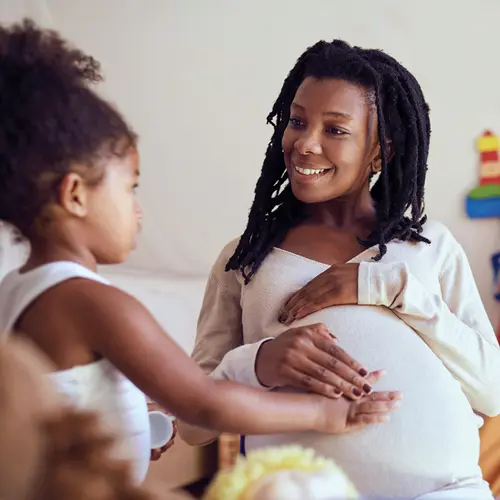You may have seen parents around town with their baby strapped to their chest or back. Baby wearing is a great way to bond with your baby. It can also free up your hands so that you can carry your baby and still get things done around the house. Other benefits include soothing a colicky baby and helping you nurse in public more discreetly.
People have been wearing their babies for thousands of years. While there are a lot of benefits of baby wearing, there are some precautions you should take as well.
What Are the Benefits of Baby Wearing?
Baby wearing can benefit both caregivers and babies. Some of the benefits include:
Happier babies. This is one of the most important reasons many people start baby wearing. Studies have shown that babies who are carried cry less. Carrying a baby for at least 3 hours per day has been shown to reduce crying. When fussiness is at its peak at around 6 weeks, babies who were held more cried 43% less during the day. They also cried 51% less during the evening hours.
Encourages breastfeeding. If you're a nursing mother, having your baby close to your chest may help make breastfeeding more convenient. This can make breastfeeding easier and more natural. In one study, women who practiced baby wearing were twice as likely to still be breastfeeding when their babies were 5 months old as women who did not.
Baby wearing can also help you practice responsive feeding. Responsive feeding is when you feed your baby based on early hunger cues rather than feed them on a schedule or wait for them to cry. A 2018 study showed that mothers who wear their babies are more likely to practice responsive feeding and more likely to still be exclusively breastfeeding at 6 months than mothers who didn't.
Healthier babies. Research has shown that skin-to-skin contact can help babies thrive. Kangaroo care, which is holding your baby skin-to-skin against your chest, has been shown to help babies:
- Sleep more
- Stabilize heart rate
- Decrease crying
- Gain weight
- Breastfeed longer
- Improve breathing patterns
- Improve oxygen saturation levels, which indicate how well oxygen is getting to a baby's organs and tissues
Of course, you can practice kangaroo care without wearing your baby, but baby wearing makes it much more convenient. A sling or carrier makes it easier for you to get work done and take care of yourself while holding your baby close and giving them all of the benefits of kangaroo care.
Is Baby Wearing Safe?
The biggest concern with baby wearing is suffocation, especially for babies under 4 months old. Babies don't have very good head control for the first few months after birth because of weak neck muscles. If your baby's mouth and nose become obstructed, they won't be able to breathe. Keeping your baby curled in a C position will also make it difficult for them to breathe.
However, as long as you are aware of what baby wearing safety experts call the "T.I.C.K.S." of baby wearing, you can enjoy all of the benefits of baby wearing and keep your baby safe. These include:
- T — Tight. The sling or carrier you use should be tight enough to keep your baby close to you.
- I — In view at all times. You should be able to see your baby's face by glancing down and without having to move the fabric.
- C — Close enough to kiss. Your baby's head should be as close to your chin as possible.
- K — Keep chin off chest. You should be able to fit at least a finger between your baby's chin and chest.
- S — Supported back. Your baby's back should be supported so that they are not slumped or curled into a C shape.
What Are the Different Types of Baby Carriers?
There are a lot of different types of carriers and slings to choose from. You may find that different ones work better depending on what you'll be doing and your baby's age. Some parents switch out carriers daily, while others have one that they use for everything from newborn snuggling at home to active days out with a toddler. No matter which carrier you choose, make sure you read the instructions that come with it and understand how to use it safely.
Baby wraps. This is probably the most versatile type of carrier. A wrap is basically a long piece of material that you use to strap your baby to your chest or back. Wraps come in stretchy knit or woven material. Once you learn to use these, they can be very comfortable. Stretchy wraps are great for newborns but may not support a toddler. Woven wraps are sturdy enough to use with older babies as well as newborns.
Pouches and ring slings. These are worn over one shoulder like a sash. The material is folded over to provide a pocket for your baby. Ring slings have a ring that you can use to adjust the sling for a better fit. Pouches are not adjustable.
Soft-structured carrier. These are similar to a backpack, though they can be worn on the front as well. They have a structured waist strap and padded shoulder straps. They also have buckles to adjust the fit.
Meh dais. These are Asian-style baby carriers made with a rectangle of fabric and straps that tie over the waist and shoulders. These are versatile carriers that can be worn on your front, back, or hip.

